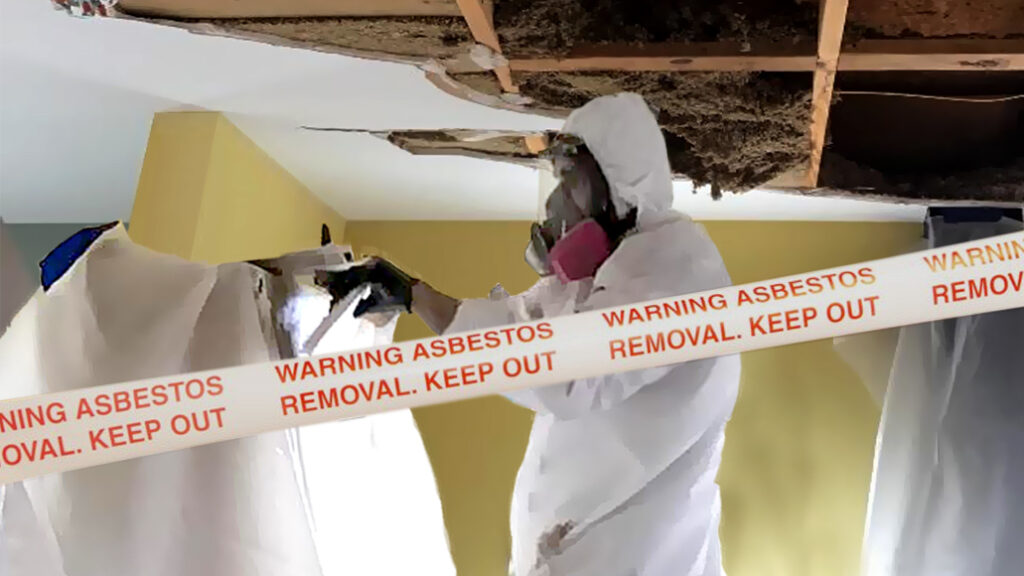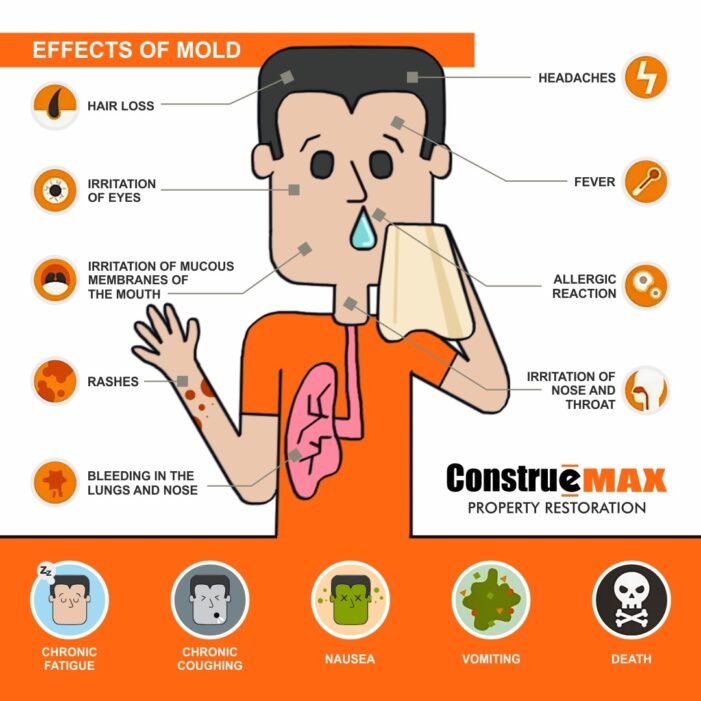Water Damage Series – Part 3: Special Cases
In Some Cases, There Are Special Requirements
This installment in the series is a quick aside. The category scheme described previously is a very effective way of describing how contaminated the water intrusion is. It is also very helpful to the technicians in developing their strategy for drying your home. But there are some circumstances that will require special attention because of the materials affected and found during the inspection.
Example Material – Asbestos
There are many different types of materials and chemicals that require special handling when found. In this post we will use two examples to illustrate the nature of special cases in mitigation

Asbestos was a very common material found in nature. It was discovered that it would not burn. Because it could be woven into fabric and was used for wicks and fire retardant clothing. Other uses for it were employed and started to be used in buildings of all types. This included schools, government buildings, arenas, office buildings, and even homes. Its resistance to fire made it a popular material and surely prevented building fires throughout the years. Unfortunately, asbestos has been determined to be a health hazard as a carcinogen.
Exposure to asbestos fibers over the years has been determined to have been the cause of many deaths. It was widely used throughout the 1900s in building materials. In the 1970s these cancer-causing risks became known and its use began to be regulated. Because of its fire-resistant properties, it was widely used. Homes and other buildings built before 1980 are quite likely to have been built using materials containing asbestos.
More Specifically Where It Might Be Found
As long as the asbestos is undisturbed it poses no threat. But when those building materials get exposed the fibers can be released into the air and there becomes a risk of inhalation. Asbestos was used in:
- Plaster
- Caulk
- Drywall
- Insulation
- Flooring
- Roofing
- Popcorn ceilings
- Other ceiling and wall texture compounds
- Siding
- Countertops
- Electrical sheathing
- HVAC ducts
- …and so many more
Bear in mind that since 1980 these materials should not have any asbestos. Newer homes and buildings are less likely to have materials containing asbestos.
As the health concerns of asbestos became better known, the use of it became very strictly regulated, including how it is removed from a building when it is found. This is where we enter the picture and become concerned with asbestos in your home.
When you have a water loss, it is very common to remove flooring, drywall, and insulation. After all of the unsalvageable and contaminated building materials are removed you might see the affected room with part of your wall cutaway, no insulation, with wall studs exposed. This is a disruptive process. If those materials contain or expose asbestos, we have to turn to the specialists – for our safety and yours.
Asbestos Abatement Specialists

The regulations about removing materials containing asbestos vary widely depending on circumstances. There are both federal and state requirements that must be followed.
In Florida, a license is required for a business to engage in asbestos abatement. A licensed company will know the regulations that apply to the circumstances encountered, and they will have the equipment, skill, and expertise to do the work according to protocol and with safety as the foremost concern.
As such, whenever asbestos is suspected, a water mitigation technician will respond appropriately and ensure that the proper experts are called in when necessary.
Regulated Materials – Many More Than Asbestos
Asbestos is possibly the most notoriously regulated building material that we have to be aware of when we are mitigating a water damage loss, but there are many other materials as well that our technicians will be on the lookout for:
- Asbestos
- Lead
- Arsenic
- Mercury
- Polychlorinated Biphenyls (PCBs)
- Ethylene Glycol
- Pesticides
- Fuels
- Solvents
- Caustic Chemicals and Radiological Residues
- …and more
Some of these will require licensed specialists to be involved with the mitigation of the water damage loss. Some on this list may only require special handling, Personal Protective Equipment (PPE), or procedures. But all require special attention and will affect how your water technician will handle the situation.
Mold/Microbial Growth
Microbial growth is very common in Florida. Mold spores are everywhere and with enough moisture, they will grow into colonies. Regulations require that when a technician observes microbial growth to exceed 10 square feet of surface area, an Industrial Hygienist (IH) must be engaged to assess the growth and to provide a mold remediation protocol.
Mold in a home, left unaddressed, will cause structural deterioration as it grows. Since it often grows in dark and hidden places like behind cabinets, behind furniture, in attics, or under carpets, it can cause extensive damage before it is discovered.
In addition to structural damage, mold can cause serious health problems. The author of this blog has experienced this personally in his own residence with a small amount of mold. When the less than one square foot of mold was removed and the area treated with a biocide, the nightly headaches immediately stopped.
I was lucky. Mold can cause headaches, cause skin irritation, and interrupt sleep. But it can also cause severe issues like respiratory problems and even death.
When you have a water loss it is very common to encounter mold. A licensed mold remediator should be called in to address it.
All Special Situations Must Be Addressed ASAP
When a special case material is discovered, it must be addressed and resolved before the restorative drying process is begun. Waiting to dry your home will only allow the water to do more damage and possibly result in more unsalvageable building material. So mold remediation and addressing the regulated material should be done as soon as possible.
Impact on the Cost of the Mitigation
In this section we’ll discuss mold specifically as our example. See the section below on insurance about asbestos and other hazardous materials.
When you look at all the differences between the different categories of water, it should be clear that as the category advances from 1 through 3 that the costs go up because of additional labor, tools, and PPE required to meet the additional workload and risks. You can see that following these regulations will dramatically increase the cost of mitigation. This is so whenever you encounter these special cases, be it regulated and/or hazardous materials or mold.
With some of these special cases, the cost of the special case may be greater than the cost of the water mitigation itself. Not only the abatement, but the reconstruction after the fact.
For example, an Industrial Hygienist (IH) who is called in to inspect could easily cost $750 for an inspection. And they have to inspect at least twice. Once to determine the scope of the infestation, and once to give the ‘all clear’ saying that the work performed by the mold remediator made the area safe again. It is not uncommon, in severe cases, that when the IH comes back out and tests for mold, it fails. They have to determine why and provide a new protocol for the mold remediation team to follow.
Experts Might Seem Expensive, But They Save You Money
Bear in mind, the hygienist is the expert on determining if the area is safe and how to make it safe. The mold remediators are obligated to follow the IH protocol. This is intended to protect against conflict of interest and liability.
The mold remediator gets paid for how much work they do. If they remove all the drywall and insulation in a room, they will get paid more than if they only remove 20 square feet of wall. If the water tech discovers microbial growth that is more than 10 square feet of surface area, they call in someone licensed to handle it. An IH is called in to identify a protocol that will resolve the problem. They tell the remediator what needs to be removed, no more – no less. Being an independent third party prevents a conflict of interest and billing you (or your insurance company) for work that didn’t need to be done.
By the same token, it is in the best interest of the homeowner to make sure you get ALL of the problem-causing mold that is present. Mold is cancer to a house. And if a person were to have surgery to remove cancer, they would want to make sure the surgeon got it all without leaving anything behind that could become a problem. The same would be true in dealing with the cancer of mold in your home or business.
Impact on the Time Required to Mitigate
When you have a special case because of hazardous materials found you can expect it to increase the amount of time involved in addressing the problem. Again we’ll address mold in this section.
When the mitigation team encounters microbial growth, if your loss is covered by insurance, your adjuster needs to be informed. First, if you have mold coverage in your policy, they have to investigate that as part of the claim so they can approve the payment. Secondly, they need to be kept informed about the progress of the mitigation. This will cause the dry out to be delayed by however long the mold remediation takes to complete. The adjuster needs to know that. The longer the restorative drying takes the greater the damage that could be incurred. That will affect the settlement for the claim.
When this happens, an IH is called out to inspect and provide a protocol. That inspection has to be scheduled. After a natural disaster like a hurricane, they are very busy. It can take days or weeks before they are able to fit your house into their schedule. Then, after the inspection, they can take a week to get the report back to the adjuster, who then has to review it before approving it.
With a mold claim, a number of people’s schedules and workload will affect your ability to move forward. Your water mitigation tech is also at the mercy of all of this other work that needs to be done.
Impact on Your Insurance Claim
Insurance premiums often feel like a waste of money when they are paid month after month or year after year and you never have a claim. But when you do have a water disaster from a burst water heater or hurricane, or whatever the cause, you are grateful when that the disaster is covered by insurance.
Insurance is not a windfall of money to you. It is money paid to you to resolve the problem you encountered, and to pay you fairly, nothing more than the loss you suffered, and nothing less. One thing insurance cannot do is take away the fact that you now have to deal with the loss and the recovery. You will have hours of time used up addressing the problem and replacing unsalvageable things.

The cost of your loss will go up by however much expense there is involved with addressing this special case scenario. The amount paid by insurance is dependent on if you have coverage, and how much your coverage is.
Mold is not always covered by insurance. Being a very humid state with many storms, it is very common in Florida. It is very common that there is a limit of $10,000 of coverage. That limit can be reached very quickly. Two inspections from an IH could eat away at 15% of that coverage off the top.
Pollutants are not Covered
Your insurance policy will determine what is and what is not covered. When your review your policy and look at exclusions, you should expect to see that pollutants are not covered. Asbestos is considered by insurance companies to be pollutants and therefore, when viewed that way, will not be covered. The cost of that abatement will have to come from you, the homeowner or business owner.
The insurance adjuster will consider this when looking at your special cases, whether its asbestos, lead, pesticides, or any of the other things that trigger special case care by your water loss mitigator.
Anytime you have a special case and that special case is covered by your insurance, everything that applies to mold remediation would be considered in that case too. Experts hired, abatement specialists, and labor, equipment, and PPE will all affect the cost of the disaster and time required to recover.
Impact on Your Health
The reason that a special case IS a special case, is that there are health concerns, either for you, the water technicians, or the environment generally. As such, you should be aware that safety is a priority in this process.
The good news is that the special care taken by remediation specialists is done with the containment of the threat as the first goal, and elimination of the threat as the end result. When it is all done, your safety should be greater than it was at the start of the loss, and in some cases, your health may even improve.
In Summary
Life is a balance of risks and rewards. Sometimes the risk comes back to bite you. It can be a lifelong dream to own a beautiful and historic home, but the risk that comes with that is the potentially hazardous materials used in its construction. If the problem hasn’t already been addressed, you may be forced into it when you experience another disaster that comes as a risk of life.
Sometimes when you have a water damage loss there are circumstances that complicate the restoration process. The additional cost incurred in time and money, while frustrating, are intended to result in a safer place to live in the long run.










